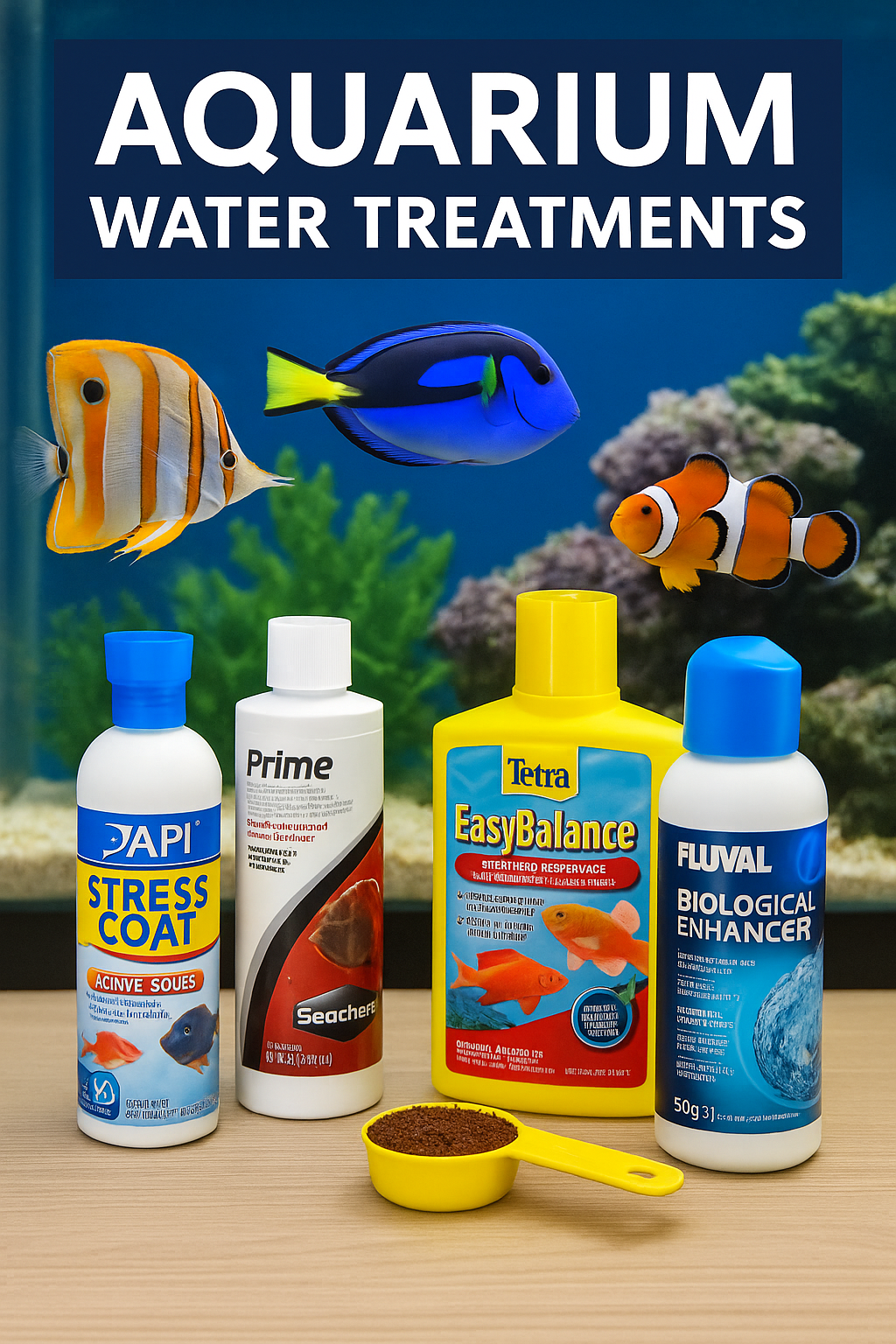For every fish enthusiast—from weekend hobbyists to advanced aquarists—maintaining clean, stable water is the cornerstone of a healthy aquarium. While filters and routine maintenance play a key role, aquarium water treatments are the secret weapon to ensuring fish not only survive but thrive.
Whether you’re cycling a new tank, managing algae blooms, dealing with ammonia spikes, or simply improving water clarity, knowing which water treatments to use—and when—is essential. But with countless bottles lining pet store shelves, how do you choose the right one?
In this comprehensive guide, we’ll explore how aquarium water treatments work, the most trusted options available, and how to apply them safely. We’ll also highlight emerging trends in the U.S. pet supplies market that are reshaping fish care for 2025 and beyond.
Why Aquarium Water Treatments Matter
Think of water in your tank as the “air” your fish breathe. Invisible to the eye, a host of toxins and imbalances can quietly build up, stressing your fish and leading to disease. Aquarium water treatments help neutralize these threats, providing a safe, consistent aquatic environment.
Key benefits of using the right water treatments include:
- Neutralizing chlorine and chloramine
- Detoxifying ammonia and nitrites
- Stabilizing pH and hardness
- Promoting beneficial bacteria
- Treating algae and cloudiness
When used correctly, water treatments are preventative care—not just a reactive solution to visible issues.
Understanding Different Types of Aquarium Water Treatments
1. Dechlorinators and Water Conditioners
Tap water in the U.S. is treated with chlorine and chloramine—chemicals deadly to fish. These treatments neutralize both instantly.
Common Ingredients: Sodium thiosulfate, detoxifying agents
Use: Every water change
Brands to Consider: Seachem Prime, API Tap Water Conditioner
2. Ammonia Neutralizers
Even in cycled tanks, sudden ammonia spikes can happen. Neutralizers bind harmful ammonia, buying you time to fix the root problem.
When to Use: After overfeeding, dead fish, or during cycling
Note: Some test kits still detect bound ammonia, causing confusion
Best Use: Emergency treatment, not long-term fix
3. Biological Enhancers
These treatments seed your tank with nitrifying bacteria to help cycle it faster and maintain biological balance.
Purpose: Supports nitrogen cycle
Use Case: New tanks, post-medication treatment
Products: Tetra SafeStart, API Quick Start
4. pH Adjusters and Buffers
Some fish need specific pH ranges. These treatments raise or lower pH and add buffering capacity to resist fluctuations.
Important: Sudden pH shifts can stress or kill fish
Tip: Always test water before and after adjusting
5. Algae Control Treatments
While algae isn’t always harmful, it can overrun tanks. Algae treatments inhibit growth, but they should be a last resort after manual cleaning and light control.
Caution: Many contain chemicals unsafe for invertebrates or live plants
Use Sparingly: Best used in planted tanks under professional guidance
6. Clarifiers
These bind suspended particles into larger clumps, making it easier for filters to clear the water. They’re cosmetic and should never replace regular maintenance.
Result: Crystal-clear water
Use: Before events or after deep cleanings
When and How to Use Water Treatments
Not all aquarium water treatments are created equal—and not all should be used at the same time. Here’s a basic rule-of-thumb timeline:
- New Tank Setup: Water conditioner, biological booster
- After Water Changes: Water conditioner (every time)
- If Ammonia/Nitrites Spike: Ammonia neutralizer
- Cloudy Water: Clarifier (optional)
- Algae Growth: Manual cleaning first, then algaecide if necessary
- Sick Fish: Use targeted medications and isolate affected fish
Read instructions carefully, measure dosages accurately, and monitor water parameters with a reliable test kit before and after any treatment.
Best Practices When Using Aquarium Water Treatments
- Test First, Treat Second: Always test water parameters before applying treatments. This ensures you’re targeting the correct issue.
- Avoid Overuse: Over-treatment can disrupt the nitrogen cycle or harm fish and plants.
- Observe Fish Behavior: Any change in swimming patterns, breathing, or appetite may signal stress from water changes or treatments.
- Consistency is Key: Use water conditioners consistently during every water change to prevent chlorine burns or toxicity.
- Don’t Mix Randomly: Avoid using multiple treatments at once unless confirmed safe by the manufacturer.
The Role of Water Treatments in Long-Term Fish Health
A consistent regimen of proper feeding, cleaning, and water care makes the best aquarium water treatments a support system—not a crutch. Fish in a well-maintained tank with optimal water chemistry are less likely to become ill, more likely to show vibrant color, and more responsive to feeding and interaction.
For beginner aquarists, treatments offer a forgiving safety net. For advanced hobbyists, they’re fine-tuning tools used to achieve ideal breeding or display conditions.
USA Market Trends in Aquarium Water Treatments
The U.S. pet industry has seen a significant spike in eco-conscious and high-performance water treatment products. Pet owners are demanding:
- Plant-safe and reef-safe formulas
- Low-chemical, natural solutions
- Multi-function conditioners that declorinate, detoxify, and promote slime coat
- Smaller ecological footprints in packaging and production
Brands are responding with more precise formulations, educational resources, and even subscription-based water treatment kits tailored to tank size and fish species.
Aquarists are also becoming more data-driven—pairing smart sensors with automated dosing pumps to optimize treatment delivery. This technology is expected to become more accessible across home aquariums in the next 3–5 years.
5 FAQs About Aquarium Water Treatments
- How often should I use aquarium water treatments?
Water conditioners should be used with every water change. Other treatments, like ammonia neutralizers or clarifiers, should be used as needed based on test results. - Can I use multiple treatments at once?
Some combinations are safe, such as water conditioner and bacteria starter. However, mixing pH adjusters with algae treatments may cause stress. Always check labels. - Are natural treatments better than chemical ones?
Not necessarily. Natural treatments are great for mild issues, but chemical treatments are more effective for serious conditions like ammonia spikes or disease outbreaks. - Do I still need a filter if I use water treatments?
Yes. Treatments do not replace mechanical, chemical, or biological filtration. They support water quality but cannot maintain it alone. - What’s the best way to store aquarium water treatments?
Keep them in a cool, dry place away from sunlight. Always tighten caps and check expiration dates, as some ingredients degrade over time.
Conclusion: Elevating Pet Care with Smart Aquarium Practices
Clean water is the foundation of a healthy aquarium. Using aquarium water treatments wisely—backed by testing, observation, and care—makes the difference between a struggling tank and a thriving aquatic habitat. Whether you’re dealing with tap water chemicals or unpredictable ammonia spikes, the right treatments simplify care and extend the life of your underwater ecosystem.
As innovation continues to drive the pet supplies industry forward, choosing the best aquarium water treatments becomes not just a matter of convenience, but of compassion. Every drop of water in your tank is part of your fish’s world—make it the best it can be.
From conditioners to bio-boosters, today’s water treatments are more effective and accessible than ever. Make informed choices, monitor regularly, and treat only when needed. In return, your fish will reward you with color, movement, and peace—swimming proof that good care makes a big difference.



